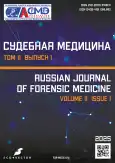Удельная электропроводность синовиальной жидкости как критерий давности наступления смерти человека при исследовании трупа в позднем посмертном периоде
- Авторы: Халиков А.А.1, Вавилов А.Ю.2, Агзамов В.В.1, Поздеев А.Р.2
-
Учреждения:
- Башкирский государственный медицинский университет
- Ижевская государственная медицинская академия
- Выпуск: Том 11, № 1 (2025)
- Страницы: 5-15
- Раздел: Оригинальные исследования
- URL: https://journal-vniispk.ru/2411-8729/article/view/287945
- DOI: https://doi.org/10.17816/fm16193
- ID: 287945
Цитировать
Полный текст
Аннотация
Обоснование. Точность определения давности наступления смерти человека имеет существенное юридическое значение, поскольку от успешности решения этого вопроса во многом зависит исход расследования преступления против жизни и здоровья граждан. Особую актуальность вопрос определения давности наступления смерти приобретает в тех случаях, когда она наступила в условиях неочевидности, а мёртвое тело исследуют в позднем посмертном периоде. При отсутствии убедительных доказательств ненасильственной смерти сотрудники следственных органов исходят из версии убийства неизвестными лицами, а точное время смерти помогает сузить круг расследования и подтвердит или опровергнуть эту версию. Однако гнилостная биотрансформация мёртвого тела затрудняет работу судебно-медицинского эксперта, снижая точность ответов на вопросы следователя, что требует поиска новых объективных экспертных критериев.
Цель исследования — изучить изменения удельной электропроводности синовиальной жидкости коленных суставов трупа при развитии его гнилостной трансформации с математическим описанием выявленных изменений на основе модели многослойного перцептрона для обоснования перспективности определения давности наступления смерти кондуктометрическим способом.
Материалы и методы. Исследованы кондуктометрические свойства синовиальной жидкости коленных суставов 103 трупов лиц, умерших в возрасте 20–87 лет по различным причинам. Анализ проводили в позднем посмертном периоде (до 10 сут). Давность наступления смерти устанавливали комплексно с учётом медицинских, судебно-медицинских и следственных данных. Измерение электропроводности проводили с помощью портативного измерителя параметров «АКИП RLC 6109» с погрешностью 0,1% при частотах 100 Гц, 1 и 10 кГц.
Результаты. Установлено, что удельная электропроводность синовиальной жидкости при частотах 100 Гц и 1 кГц достоверно зависит от давности смерти. Оптимальная математическая модель, описывающая данную взаимосвязь, — полином второй степени. Также предложена модель с архитектурой многослойного перцептрона 2-5-1, обеспечивающая расчёт с погрешностью, не превышающей установленного в работе предела (достоверность >95%).
Заключение. Кондуктометрический анализ синовиальной жидкости коленных суставов трупа в позднем постмортальном периоде позволяет достоверно выявлять изменения её удельной электропроводности, обусловленные временем, прошедшим с момента смерти. Эти изменения могут служить основой для математической модели расчёта давности наступления смерти в позднем посмертном периоде. Наиболее точные предсказания обеспечивает модель № 2 с архитектурой многослойного перцептрона 2-5-1, что делает её наиболее пригодной для решения данной задачи.
Полный текст
Открыть статью на сайте журналаОб авторах
Айрат Анварович Халиков
Башкирский государственный медицинский университет
Email: airat.expert@mail.ru
ORCID iD: 0000-0003-1045-5677
SPIN-код: 1895-7300
доктор медицинских наук, профессор
Россия, 450008, Уфа, ул. Ленина, д. 3Алексей Юрьевич Вавилов
Ижевская государственная медицинская академия
Email: izhsudmed@hotmail.com
ORCID iD: 0000-0002-9472-7264
SPIN-код: 3275-3730
доктор медицинских наук, профессор
Россия, ИжевскВадим Валерьевич Агзамов
Башкирский государственный медицинский университет
Автор, ответственный за переписку.
Email: expert.sudmed@yandex.ru
ORCID iD: 0000-0001-9845-2280
SPIN-код: 2601-5385
MD
Россия, 450008, Уфа, ул. Ленина, д. 3Алексей Родионович Поздеев
Ижевская государственная медицинская академия
Email: apozdeev@bk.ru
ORCID iD: 0000-0002-6302-5219
SPIN-код: 2242-4828
доктор медицинских наук, доцент
Россия, ИжевскСписок литературы
- Tenkov AA, Plaksin VO. Forensic examination of a corpse in the late postmortem period: (rotting, adipocere, mummification, damage assessment): monograph. Kursk: Publishing House of Kursk State Medical University; 2005. (In Russ.) EDN: QLKVZL
- Tomilin VV, Zharov VV, Melnikov GM. Determining the time of death. Forensic Medical Expertise. 1984;27(4)44–47. (In Russ.)
- Froede RC. Handbook of forensic pathology. 2nd edition. College of American pathologist; 2003.
- Kil’dyushov EM, Ermakova YuV, Tumanov EV, Kuznetsova GS. Estimation of time since death in the late postmortem period in forensic medicine (literature review). Russian Journal of Forensic Medicine. 2018;4(1):34–38. doi: 10.19048/2411-8729-2018-4-1-34-38 EDN: YWDARF
- Indiaminov SI, Zhumanov ZE, Blinova SA. Problems of establishing the prescription of death. Forensic Medical Expertise. 2020;63(6):45–50. doi: 10.17116/sudmed20206306145 EDN: FXLSCS
- Sadrtdinov A, Khalikov A, Kanzafarova G. Photocolorimetric diagnosis of period of death, for the examination of putrid transformed corpse. Meditsinskaya ekspertiza i parvo. 2016;(5):32–36. EDN: WWYWFT
- Sadrtdinov AG, Vavilov AYu, Khalikov AA, Naydenova TV. Determination of time of death by photocolorimetric method in putrid biotransformation corpse. Modern problems of science and education. 2017;(2):10. EDN: YLKHRZ
- Popov VL, Kazakova EL, Lavrukova OS, Polyakov AY. On the prospects of the impedance monitoring method for determining the prescription of death coming. Forensic Medical Expertise. 2023;66(2):20–25. doi: 10.17116/sudmed20236602120 EDN: MQZICF
- Yumashev GS. Traumatology and orthopedics. 2nd edition. Moscow: Meditsina; 1983. (In Russ.)
- Tarnovskaya LI. Statistics: a study guide. Tomsk: Publishing House of Tomsk Polytechnic University; 2008. (In Russ.)
Дополнительные файлы













